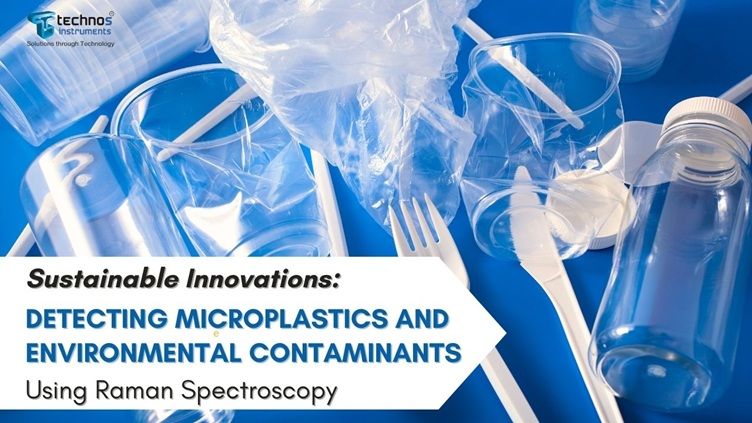
Sustainable Innovations: Detecting Microplastics and Environmental Contaminants Using Raman Spectroscopy
Sustainable Innovations: Detecting Microplastics and Environmental Contaminants Using Raman Spectroscopy
March 1, 2025

Introduction
Microplastics and environmental contaminants pose a significant threat to ecosystems and human health. These tiny particles and pollutants infiltrate our water, soil, and even the air we breathe, leading to widespread concerns among scientists, environmentalists, and policymakers. As plastic pollution continues to escalate, the need for innovative solutions to detect and mitigate its impact becomes increasingly urgent.
Raman spectroscopy—a powerful, non-destructive analytical tool that is revolutionizing how we identify microplastics and other pollutants at a molecular level. This article explores how this technology is making a difference and what the future holds for cleaner ecosystems.
Effects of Environmental Contaminants and Microplastics on Human Health: A Technical Perspective
Both environmental contaminants and microplastics pose significant risks to human health due to their persistent nature, bioaccumulation potential and ability to interact with biological systems at the molecular level. Exposure occurs through ingestion, inhalation and dermal contact, leading to various physiological and biochemical disruptions.
Impact of Microplastics on Human Health
Microplastics (<5 mm) made of synthetic polymers (PE, PP, PS, PET etc.) carry toxic additives and pollutants, penetrating biological tissues and posing health risks, some of which are mentioned below
• Respiratory Effects – Inhaled microplastics (<10 µm) reach the lungs, causing oxidative stress, inflammation, and fibrosis.
• Gastrointestinal Disruptions – Ingested microplastics alter gut microbiota, increasing permeability and systemic inflammation.
• Endocrine Disruption – Containing EDCs like BPA and phthalates, microplastics interfere with hormonal functions, affecting reproduction and metabolism.
• Genotoxic & Carcinogenic Potential – Nanoplastics (<1 µm) may cause DNA damage, chromosomal mutations, and cancer risk.
Detecting Environmental Contaminants and Microplastics
Detecting environmental contaminants and microplastics requires advanced analytical techniques to identify, quantify and characterize pollutants at micro- and nano-scales. Various methods are employed based on their sensitivity, specificity and ability to analyse complex environmental matrices.
Impact of Microplastics on Human Health
Microplastics (<5 mm) made of synthetic polymers (PE, PP, PS, PET etc.) carry toxic additives and pollutants, penetrating biological tissues and posing health risks, some of which are mentioned below
• Respiratory Effects – Inhaled microplastics (<10 µm) reach the lungs, causing oxidative stress, inflammation, and fibrosis.
• Gastrointestinal Disruptions – Ingested microplastics alter gut microbiota, increasing permeability and systemic inflammation.
• Endocrine Disruption – Containing EDCs like BPA and phthalates, microplastics interfere with hormonal functions, affecting reproduction and metabolism.
• Genotoxic & Carcinogenic Potential – Nanoplastics (<1 µm) may cause DNA damage, chromosomal mutations, and cancer risk.
Detecting Environmental Contaminants and Microplastics
Detecting environmental contaminants and microplastics requires advanced analytical techniques to identify, quantify and characterize pollutants at micro- and nano-scales. Various methods are employed based on their sensitivity, specificity and ability to analyse complex environmental matrices.
Raman Spectroscopy: Preferred Microplastic Detection Technique, a Case Study:
Raman spectroscopy excels in microplastic detection due to its high molecular specificity, non-destructive nature, and ability to detect micro- and nano-scale particles. Using the IndiRAM CTR500, we achieved superior results in detecting PP and PET in waste. This method outperforms compared to the other Methods listed in the table above, offering rapid, precise, and in situ analysis across diverse environments.
Key Technical Advantages of Raman Spectroscopy
Molecular Fingerprinting with High Specificity
Quick Turnaround time in Detection of Micro- and Nanoplastics
Non-Destructive and Minimal Sample Preparation
Analysis in Complex Environmental Matrices
Portable and In-Field Detection Capabilities
Conclusion
Raman Spectroscopy stands out as the most efficient technique for detecting microplastics and environmental contaminants due to its high sensitivity, non-destructive nature, and ability to analyze nano-sized particles with minimal preparation. Its versatility makes it an essential tool for environmental scientists and regulatory agencies tackling microplastic pollution.
TechnoS Instruments is doing a great job in advancing Raman spectroscopy with their IndiRAM CTR Series and General Purpose System, providing cutting-edge solutions for precise and reliable analysis.
Follow TechnoS Instruments for more insights on cutting-edge Raman Spectroscopy applications!
Related Articles
- Behind the Pills Identifier: Unmasking Illicit Drugs with Raman Spectroscopy
- Crystal Clarity: Understanding Quartz Through Raman Spectroscopy
- Field Testing Simplified: Benefits of Portable Raman Spectrometers
- Gemstone Identification with Raman Spectroscopy: Preserving Purity, Authenticity, and Trust in the Industry
- IndiRAM Raman Spectrometer for identification of Excipients in Pharmaceutical Drugs
- Innovations in Raman Spectroscopy: TechnoS at the Forefront
- Microplastic Contamination Detection in Food Grains: A Raman Spectroscopy Approach
- Powering the Future: How Raman Spectroscopy is Advancing Battery Material Analysis
- Principle of Raman Spectroscopy & Core Components
- Raman Spectroscopy: A Transformative Tool Across Science, Industry, and Society